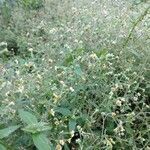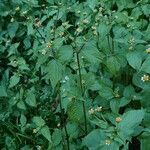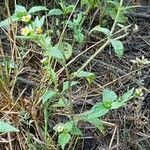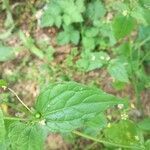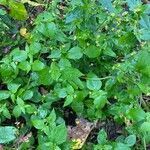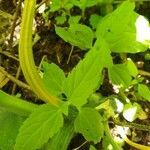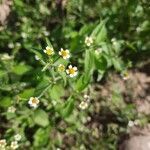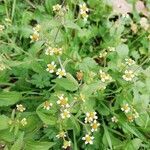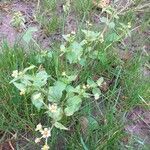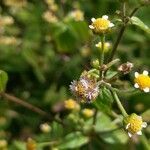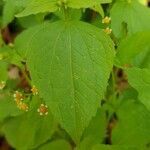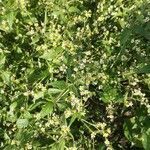Annual herb 10-75(-100) cm high, erect, spreading or decumbent; branches hispidulous or pilose, glabrescent. Leaves petiolate, membranous, ovate, 1-11 cm long, 0.5-7 cm wide, base broadly cuneate, margins crenate to subentire, apex acute or acuminate, scabridulous-pilose or glabrous on both surfaces; 3-veined from base; petiole to 25 mm long. Capitula in few-headed cymes in upper leaf-axils, globose, on slender stalks to 2 cm long; involucre 2.5-3.5 mm long; phyllaries green, membranous, ovate, pilose or glabrous; paleae 3-fid, to 2.6 mm long, ciliolate. Ray florets white, 4-5(-8), the ray broadly ovate, 0.8-2 mm long, 3-lobed, tube 0.8-1 mm long, pilose; disc florets yellow or less often orange, 0.8-1.4 mm long, the tube puberulous. Achenes 1.2-2.5 mm long, puberulous; pappus absent or of 15-20 ovate laciniate scales, usually obtuse at apex, 1-1.5 mm long.
Annual herb, up to 500 mm high. Leaves opposite; blade ovate, up to 60 x 40 mm, apex acute or acuminate, base broadly cuneate, margins subentire to serrate-crenate, hispidulous or glabrescent, 3-veined from base; petiole up to 15 mm long. Heads radiate; peduncles long, cymosely arranged at branch tips and upper leaf axils, with hairs short, appressed-ascending and few, short, glandular hairs. Involucral bracts 1-or 2-seriate, ovate, free. Receptacle with paleae trifid. Flowers: ray florets female, fertile, small; disc florets bisexual; ray and disc florets white; Dec.-Mar., Jun. Fruit dimorphic; cypsela of ray florets obovate, somewhat compressed; cypsela of disc florets narrowly turbinate, angled. Pappus absent or vestigial in ray cypsela, of disc cypsela fimbriate scales without marked terminal awn.
Slender annual herb, sparsely pubescent, sometimes glandular-pubescent; stems branched, (8–) 30–60 (–75) cm high. Leaves with petiole 5–25 mm long; lamina lanceolate to ovate, (17–) 20–60 mm long, (8–) 10–35 mm wide, cuneate, rounded or subtruncate at base, entire to serrulate, acute to subacuminate, sparsely pubescent. Capitula 3–6 mm diam., in loose terminal and axillary cymes, long-pedunculate; involucral bracts c. 7–10, ovate, 1–3 mm long; outermost paleae broadly elliptic to obovate, entire or laciniate, basally adnate to inner involucral scales; inner paleae narrower, often ±persistent. Ray florets usually 5, white or tinged pink; ligule 0.5–1.5 mm long, c. 1 mm wide, 3-lobed. Achenes 1.5–2 mm long, black, weakly pilose near apex. Pappus of numerous fimbriate scales.
Annual herb, 0.07-0.50 m high; glabrous, leafy. Leaves opposite, petiolate, ovate, membranous, base broadly cuneate, apex acuminate, margins subentire to serrate-crenate. Capitula radiate, pedunculate, in small cymes, terminal; involucre hemispherical; bracts ovate. Receptacle conical, paleate; paleae flat, membranous. Ray florets female, fertile; corolla white, strap-shaped. Disc florets bisexual, fertile; corolla yellow, cylindric, 5-toothed. Anthers oblong, faintly sagittate at base, with suborbicular apical appendage. Style linear; branches of ray florets linear-lanceolate. Flowering time Sept.-Apr. Pappus scales fimbriate. Cypselae usually dorsiventrally compressed, enclosed by group of connate involucral bracts and paleae.
Much like no. 1 [Galinsoga quadriradiata Ruiz & Pav.], less hairy, the stem glabrous or sparsely pubescent with appressed or sometimes spreading hairs, the peduncles appressed-hairy, or finely villous with spreading, gland-tipped hairs; lvs ovate or lance-ovate, mostly less coarsely toothed; outer invol bracts 2–4, scarious-margined, persistent, the inner ones and their attached pales also persistent; inner receptacular bracts deeply trifid; achenes sparsely appressed-hairy or glabrous; pappus scales of the disk-fls conspicuously fimbriate, generally blunt, nearly or quite as long as the cor; rays to 1.5(–2) mm, nearly or quite epappose; 2n=16. Native from sw. U.S. to S. Amer., but now a cosmopolitan weed.
Plants 4-60 cm. Leaf blade 7-110 × 3-70(-80) mm. Peduncles 1-40 mm; involucres campanulate, 2.5-5 mm in diam.; phyllaries persistent; outer paleae persistent with distal inner phyllaries or deciduous, elliptic to obovate, inner usually persistent, lanceolate to ovate or obovate, 2-3.5 mm, 3-lobed, lobes to 1/3+ total lengths, acute. Ray florets (3-)5(-8); corollas usually dull white or pink, lamina 0.5-1.8 × 0.7-1.5 mm. Disk florets 15-50. Ray achenes 1.5-2.5 mm; pappus absent or of 5-10 laciniate scales 0.5-1 mm; disk achenes 1.3-2.5 mm, glabrous or strigose; pappus absent or of 15-20 gray, sometimes white, linear, fimbriate, obtuse or acute scales 0.5-2 mm. Fl. Jul-Oct. 2n = 16.
Plants 4–60 cm. Leaf blades 7–110 × 3–70(–80) mm. Peduncles 1–40 mm. Involucres campanulate, 2.5–5 mm diam. Phyllaries persistent. Paleae: outer persistent with distal phyllaries or falling, elliptic to obovate; inner usually persistent, lanceolate to ovate or obovate, 2–3.5 mm, 3-lobed, lobes to 1/3+ total lengths, acute. Ray florets (3–)5(–8); corollas usually dull white (pink), laminae 0.5–1.8 × 0.7–1.5 mm. Disc florets 15–50. Cypselae: rays 1.5–2.5 mm; discs 1.3–2.5 mm, glabrous or strigose; pappi: rays 0 or of 5–10, laciniate scales 0.5–1 mm; discs 0, or of 15–20 white or gray, linear, fimbriate, obtuse (acute) scales 0.5–2 mm.
An annual herb. It grows to 75 cm high and has a spread of 50 cm. The stem is erect and much branched. The stem is rather weak. The leaves are oval and opposite. The leaves have leaf stalks are the leaves are toothed around the edge. The flowers are small and daisy like. They occur in small clusters and have white rays and a yellow disk. The flowers are produced in the axils of the upper leaves.
Annual herb, up to 500 mm tall. Peduncle hairs short, appressed-ascending, with a few short glandular hairs. Receptacular paleae trifid. Pappus scales without marked terminal awn. Flowers white.
